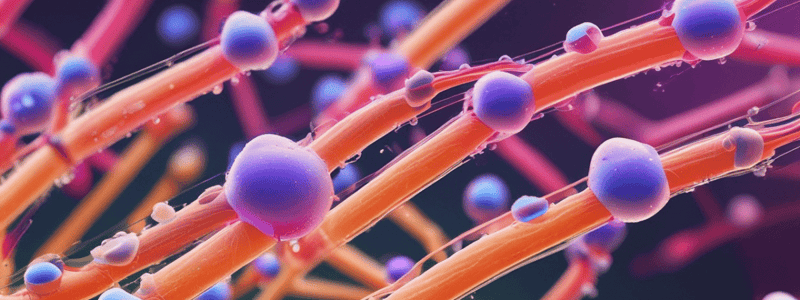Podcast
Questions and Answers
What is the main function of hyaluronic acid in the ground substance?
What is the main function of hyaluronic acid in the ground substance?
- To facilitate the movement of cells and sperm
- To provide structure and support
- To provide adhesive features to cartilage and bone
- To trap water and make the ground substance more jelly-like (correct)
What is the role of hyaluronidase in the ground substance?
What is the role of hyaluronidase in the ground substance?
- It makes the ground substance more liquid, allowing for easier movement (correct)
- It increases the viscosity of the ground substance
- It provides adhesive features to the ground substance
- It produces hyaluronic acid
Which of the following is a key component of hyaluronic acid?
Which of the following is a key component of hyaluronic acid?
- Chondroitin sulfate
- Glucuronic acid (correct)
- Keratan sulfate
- Dermatan sulfate
What is the primary function of hyaluronic acid in the eye?
What is the primary function of hyaluronic acid in the eye?
What is the relationship between thyroid disease and the deposition of glycosaminoglycans in the eye?
What is the relationship between thyroid disease and the deposition of glycosaminoglycans in the eye?
Which of the following glycosaminoglycans is found in bone and cartilage?
Which of the following glycosaminoglycans is found in bone and cartilage?
What is the composition of hyaluronic acid?
What is the composition of hyaluronic acid?
Which of the following is true about hyaluronic acid?
Which of the following is true about hyaluronic acid?
What makes hyaluronic acid unusual compared to other glycosaminoglycans?
What makes hyaluronic acid unusual compared to other glycosaminoglycans?
Which of the following is NOT a function of hyaluronic acid in the body?
Which of the following is NOT a function of hyaluronic acid in the body?
In which of the following tissues is hyaluronic acid most abundant?
In which of the following tissues is hyaluronic acid most abundant?
What is the primary mechanism by which hyaluronic acid promotes wound healing?
What is the primary mechanism by which hyaluronic acid promotes wound healing?
Which of the following statements about hyaluronic acid is TRUE?
Which of the following statements about hyaluronic acid is TRUE?
What is the primary mechanism by which hyaluronic acid contributes to joint lubrication?
What is the primary mechanism by which hyaluronic acid contributes to joint lubrication?
Which of the following statements about hyaluronic acid is FALSE?
Which of the following statements about hyaluronic acid is FALSE?
Study Notes
Ground Substance
- Composed of a mixture of water, proteins (e.g., gelatin), and polysaccharides (sugars)
- Glycosaminoglycans (GAGS) join with core proteins to form proteoglycans
- GAGS are long, unbranched polysaccharides with repeating disaccharide units
- Amino sugar examples: N-acetylglucosamine, Uronic sugar examples: glucuronic acid
Hyaluronic Acid
- A glycosaminoglycan (GAG) that is not sulfated or covalently bound to a core protein
- Forms a viscous, slippery substance that binds cells together, lubricates joints, and maintains the shape of the eyeball
- Hyaluronidase breaks down hyaluronic acid, making the ground substance more liquid
Applications of GAGS
- Hyaluronic acid: lubricates joints, maintains eyeball shape, and binds cells together
- Chondroitin sulfate: provides support and adhesive features in cartilage, bone, skin, and blood vessels
- Keratan sulfate: found in bone, cartilage, and cornea of the eye
- Dermatan sulfate: found in skin, tendons, blood vessels, and heart valves
Abnormal ECM and Thyroid Disease
- Exophthalmos (bulging eyes) is associated with abnormal ECM deposition and thyroid disease (goiter)
- Autoimmune over-activation of thyroid gland and autoimmune action on fibroblasts in ECM of the eye
Connective Tissue and Extracellular Matrix
- CT = ECM + Cells
- ECM = GS + Fibers
- ECM is composed of ground substance and fibers
- Ground substance is composed of water, proteins, and polysaccharides (GAGS)
Bone Structure
- Osteon structure consists of lamellae, lacunae, canaliculi, and central (Haversian) canal
- Lamellae: concentric rings of mineral salts and collagen for hardness and tensile strength
- Lacunae: small spaces between lamellae that contain mature bone cells (osteocytes)
- Canaliculi: minute canals that radiate from lacunae and provide routes for oxygen, nutrients, and waste
- Central (Haversian) canal: contains blood, lymph, and nerves
Mature Connective Tissues
- Blood: liquid connective tissue composed of plasma (ECM) and formed elements (red cells, white cells, and platelets)
- Erythrocytes transport oxygen and carbon dioxide, while leukocytes combat disease through phagocytosis
Studying That Suits You
Use AI to generate personalized quizzes and flashcards to suit your learning preferences.
Related Documents
Description
Test your knowledge about glycosaminoglycans (GAGs) and hyaluronic acid, including their functions and properties in the body. Explore the role of hyaluronic acid in lubricating joints, binding cells together, and maintaining the shape of the eyeball.




